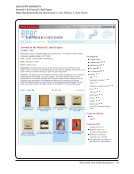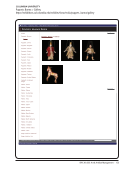74 · Representative Documents: Collection Development Policies
Library of Congress
Collections Policy Statement. Fine and Applied Arts—Non Book Materials (Graphic Arts)
http://www.loc.gov/acq/devpol/fartnonb.pdf
as records of American historical events and American urban and rural buildings, structures,
and scenery.
5. The Library will not acquire drawings for portraits of American public figures that duplicate
the efforts of the National Portrait Gallery. The Library collects drawings of American public
figures associated with major court trials.
D. Architectural and engineering drawings and documentation
1. The Library acquires selected original drawings by significant or potentially significant
American architects, designers and planners that serve as primary research materials for the
study of architecture in the United States, its territories and possessions. The Library will not
normally collect detailed engineering drawings, or the entire output of an architect's office. It
does attempt to build a documentary collection of drawings and related materials showing the
history, monuments, and achievements of architecture and civil engineering in the United
States. The emphasis will be on buildings other than those erected by the Federal government,
since the National Archives and Records Administration is responsible for the building records of
the majority of these structures.
2. In attempting to document the history of architecture, design and engineering, the Library
seeks selected measured drawings, photographs, and other documentation of existing, lost and,
in some cases, unexecuted buildings characteristic building types and technologies historic
structures and the work of notable architects, craftsmen, engineers, landscape architects,
urban planners and interior designers active in the United States. These materials include, but
are not limited to, the Historic American Buildings Survey (HABS) /Historic American
Engineering Record (HAER) /Historic American Landscapes Survey (HALS). The Library does not
attempt, in general, to build large collections of original engineering or technical drawings,
blueprints and specifications. The Library, rather, attempts to coordinate its acquisitions in the
field of historic engineering with those of the National Museum of American History in order to
avoid duplication.
3. In building a collection of materials associated with the built environment, the Library
considers for acquisition selected drawings, photographs, and other documentation of buildings
or sites outside the United States representing particular designers, techniques, building types
and styles, technical or design innovations, etc., that have had notable impact on work in the
United States or were influenced by work in this country.
4. Materials relating to foreign buildings and sites that substantially strengthen or supplement
the existing holdings of the Library, or fill notable gaps in the Library's record of the history of
architecture in all countries are acquired.
5. For Western architecture before 1800, the Library attempts to coordinate its acquisitions
with those of the National Gallery of Art in order to avoid duplication. Similarly, the Library
works with the Dumbarton Oaks Library to avoid duplication in the field of garden and
landscape architecture.
6. In general, the Library does not endeavor to build large collections of original architectural
drawings, blueprints and specifications relating to the construction and building trades, as
these fall within the scope of the collections of the National Building Museum.
7. The Library, as part of its work towards the Cooperative Preservation of Architectural
Records (COPAR), encourages the placement of archives of limited subject or geographical
4
Library of Congress
Collections Policy Statement. Fine and Applied Arts—Non Book Materials (Graphic Arts)
http://www.loc.gov/acq/devpol/fartnonb.pdf
as records of American historical events and American urban and rural buildings, structures,
and scenery.
5. The Library will not acquire drawings for portraits of American public figures that duplicate
the efforts of the National Portrait Gallery. The Library collects drawings of American public
figures associated with major court trials.
D. Architectural and engineering drawings and documentation
1. The Library acquires selected original drawings by significant or potentially significant
American architects, designers and planners that serve as primary research materials for the
study of architecture in the United States, its territories and possessions. The Library will not
normally collect detailed engineering drawings, or the entire output of an architect's office. It
does attempt to build a documentary collection of drawings and related materials showing the
history, monuments, and achievements of architecture and civil engineering in the United
States. The emphasis will be on buildings other than those erected by the Federal government,
since the National Archives and Records Administration is responsible for the building records of
the majority of these structures.
2. In attempting to document the history of architecture, design and engineering, the Library
seeks selected measured drawings, photographs, and other documentation of existing, lost and,
in some cases, unexecuted buildings characteristic building types and technologies historic
structures and the work of notable architects, craftsmen, engineers, landscape architects,
urban planners and interior designers active in the United States. These materials include, but
are not limited to, the Historic American Buildings Survey (HABS) /Historic American
Engineering Record (HAER) /Historic American Landscapes Survey (HALS). The Library does not
attempt, in general, to build large collections of original engineering or technical drawings,
blueprints and specifications. The Library, rather, attempts to coordinate its acquisitions in the
field of historic engineering with those of the National Museum of American History in order to
avoid duplication.
3. In building a collection of materials associated with the built environment, the Library
considers for acquisition selected drawings, photographs, and other documentation of buildings
or sites outside the United States representing particular designers, techniques, building types
and styles, technical or design innovations, etc., that have had notable impact on work in the
United States or were influenced by work in this country.
4. Materials relating to foreign buildings and sites that substantially strengthen or supplement
the existing holdings of the Library, or fill notable gaps in the Library's record of the history of
architecture in all countries are acquired.
5. For Western architecture before 1800, the Library attempts to coordinate its acquisitions
with those of the National Gallery of Art in order to avoid duplication. Similarly, the Library
works with the Dumbarton Oaks Library to avoid duplication in the field of garden and
landscape architecture.
6. In general, the Library does not endeavor to build large collections of original architectural
drawings, blueprints and specifications relating to the construction and building trades, as
these fall within the scope of the collections of the National Building Museum.
7. The Library, as part of its work towards the Cooperative Preservation of Architectural
Records (COPAR), encourages the placement of archives of limited subject or geographical
4


















































































































































































